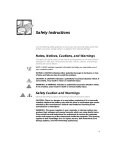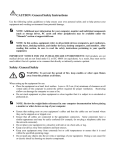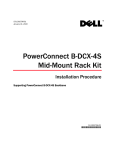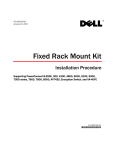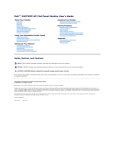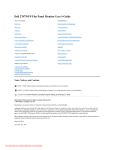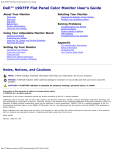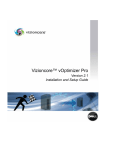Download Dell AC Adapter Safety Operating instructions
Transcript
CAUTION: Safety Instructions Use the following safety guidelines to help ensure your own personal safety and to help protect your equipment and working environment from potential damage. NOTE: Additional regulatory information for the equipment addressed by this document may be found on the Regulatory Compliance website at dell.com/regulatory_compliance. NOTE: Additional user information for your equipment (such as storage drives, PC cards and other peripherals) may be available in the “Manuals” section at support.dell.com. SAFETY: General Safety CAUTION: The power supplies in your system may produce high voltages and energy hazards, which can cause bodily harm. Unless you are instructed otherwise by Dell, only trained service technicians are authorized to remove the covers and access any of the components inside the system. This warning applies to Dell™ PowerEdge™ servers and Dell PowerVault™ storage systems. CAUTION: This system may have more than one power supply cable. To reduce the risk of electrical shock, a trained service technician may need to disconnect all power supply cables before servicing the system. IMPORTANT NOTICE FOR USE IN HEALTHCARE ENVIRONMENTS: Dell products are not medical devices and are not listed under UL or IEC 60601 (or equivalent). As a result, they must not be used within 6 feet of a patient or in a manner that directly or indirectly contacts a patient. NOTE: Some equipment may be utilized as a stand-alone device or as a rackmounted system component. Confirm in your product documentation whether your equipment is intended to be rack mounted only. Refer to additional instructions and safety information for rack mounting within this document. When setting up the equipment for use: • Place the equipment on a hard, level surface. • Do not place your equipment in a closed-in wall unit, or on a soft, fabric surface such as a bed, sofa, carpet, or a rug. • Leave 10.2 cm (4 in) minimum of clearance on all vented sides of the equipment to permit the airflow required for proper ventilation. Restricting airflow can damage the equipment or cause a fire. • Ensure that nothing rests on your equipment’s cables and that the cables are not located where they can be stepped on or tripped over. • Keep your equipment away from radiators and heat sources. • Keep your equipment away from extremely hot or cold temperatures to ensure that it is used within the specified operating range. • Do not stack equipment or place equipment so close together that it is subject to recirculated or preheated air. • Move equipment with care; ensure that all casters and/or stabilizers are firmly connected to the system. Avoid sudden stops and uneven surfaces. The following statement applies only to rack-installed PowerEdge and PowerVault products that are GS-Marked: This equipment is not intended for use at workplaces with visual display units, in accordance with §2 of the German ordinance for workplaces with visual display units. NOTE: Review the weight limits referenced in your equipment documentation before placing a monitor or other device on top of your equipment. NOTICE: To help avoid damaging your equipment, be sure the voltage selection switch (if provided) on the power supply is set for the voltage that most closely matches the AC power available in your location. Also be sure that your monitor and attached devices are electrically rated to operate with the power available in your location. WARNING: To prevent the spread of fire, keep candles or other open flames away from this product at all times. When operating your equipment: CAUTION: Do not operate your equipment with any cover(s) (including computer covers, bezels, filler brackets, front-panel inserts, etc.) removed. • Use the product only with approved equipment. • Operate the equipment only from the type of external power source indicated on the electrical ratings label. If you are not sure of the type of power source required, consult your service provider or local power company. • Do not operate the equipment within a separate enclosure unless adequate intake and exhaust ventilation are provided on the enclosure that adhere to the guidelines listed above. • Do not restrict airflow into the equipment by blocking any vents or air intakes. • Avoid placing loose papers underneath your equipment. • Do not push any objects into the air vents or openings of your equipment. Doing so can cause fire or electric shock by shorting out interior components. • Do not use your equipment in a wet environment, for example, near a bath tub, sink, or swimming pool or in a wet basement. • Use only approved power cable(s). If you have not been provided with a power cable for the equipment or for any AC-powered option intended for the equipment, purchase a power cable that is approved for use in your country. The power cable must be rated for the equipment and for the voltage and current marked on the equipment’s electrical ratings label. The voltage and current rating of the cable should be greater than the ratings marked on the equipment. • To help prevent electric shock, plug the equipment and peripheral power cables into properly grounded electrical outlets. These cables are equipped with three-prong plugs to help ensure proper grounding. Do not use adapter plugs or remove the grounding prong from a cable. If you must use an extension cable, use a 3-wire cable with properly grounded plugs. • Observe extension cable and power strip ratings. Ensure that the total ampere rating of all equipment plugged into the extension cable or power strip does not exceed 80 percent of the ampere ratings limit for the extension cable or power strip. • To help protect your equipment from sudden, transient increases and decreases in electrical power, use a surge suppressor, line conditioner, or uninterruptible power supply (UPS). • Position equipment cables and power cables carefully; route cables so that they cannot be stepped on or tripped over. Be sure that nothing rests on any cables. • Do not modify power cables or plugs. Consult a licensed electrician or your power company for site modifications. Always follow your local/national wiring rules. • When connecting or disconnecting power to hot-pluggable power supplies observe the following guidelines: • • • Install the power supply before connecting the power cable to the power supply. Unplug the power cable before removing the power supply. If the equipment has multiple sources of power, disconnect power from the system by unplugging all power cables from the power supplies. • Do not use AC powered equipment during an electrical storm. Battery powered devices may be used if all cables have been disconnected. • Before you clean your equipment, disconnect it from the electrical outlet. Clean your equipment with a soft cloth dampened with water. Do not use liquids or aerosol cleaners, which may contain flammable substances. • Clean the air vents on the front, back, and sides of the system with a clean, damp cloth. Lint, dust and other foreign materials can block the vents and restrict the airflow. • Do not spill food or liquids on equipment components, and never operate the equipment in a wet environment. If the system gets wet, see “SAFETY: If Your System Gets Wet.” • If any of the following conditions occur, unplug the equipment from the electrical outlet and replace the part or contact your trained service provider: • • • • • The power cable, extension cable, or plug is damaged. An object has fallen into the equipment. The equipment has been exposed to water. The equipment has been dropped or damaged. The equipment does not operate correctly when you follow the operating instructions. CAUTION: Incorrectly installing or using an incompatible battery may increase the risk of fire or explosion. Replace the battery only with the same or equivalent type recommended by the manufacturer, carefully following installation instructions. Dispose of used batteries properly (see “SAFETY: Battery Disposal”). • Handle batteries carefully. Do not disassemble, crush or puncture batteries. Do not short external contacts, dispose of batteries in fire or water, or expose batteries to temperatures higher than 60 degrees Celsius (140 degrees Fahrenheit). Do not attempt to open or service batteries. Replace batteries only with batteries designated for the equipment. SAFETY: Modems, Telecommunications, or Local Area Network Options If your system includes a modem, the cable used with the modem should be manufactured with a minimum wire size of 26 American wire gauge (AWG) and an FCC-compliant RJ-11 modular plug. • Do not connect or use a modem during a lightning storm. There may be a risk of electrical shock from lightning. • Never connect or use a modem in a wet environment. • Do not plug a modem or telephone cable into the network interface controller (NIC) receptacle. • Disconnect the modem cable before opening an equipment enclosure, touching or installing internal components, or touching an uninsulated modem cable or jack. SAFETY: Equipment with Laser Devices CAUTION: Except as expressly instructed otherwise in Dell documentation, only trained service technicians are authorized to remove the system cover and access any of the components inside the system. • This equipment may contain Optical Disk Drives (ODD), such as a CD-ROM, CDR/W, DVD drive, etc., which have built-in laser devices. To prevent any risk of exposure to laser radiation, do not disable or open any ODD assembly for any reason. • This equipment may contain a Host Bus Adapter (HBA) which may have a built-in laser device. • These ODDs and HBAs comply with safety requirements and are classified as Class 1 Laser Products, under the US DHHS Standard and IEC/EN60825-1 Laser Safety Standard. These ODD devices do not contain adjustments or any user serviceable or replaceable parts. SAFETY: When Working Inside Your Equipment Do not attempt to service the equipment yourself, except as explained in your Dell documentation or in instructions otherwise provided to you by Dell. Always follow installation and service instructions closely. CAUTION: Opening or removing covers that are marked with the triangular symbol with a lightning bolt may expose you to risk of electrical shock. Components inside these compartments should be serviced only by a trained service technician. • Allow the equipment to cool before removing covers or touching internal components. PC Cards may become very warm during normal operation. Use care when removing PC Cards after their continuous operation. CAUTION: The memory modules can become extremely hot during operation. Allow the modules sufficient time to cool before handling. • To help avoid possible damage to the system board, wait 5 seconds after turning off the equipment before removing a component from the system board or disconnecting a peripheral device from the equipment. • To help avoid the potential hazard of electric shock, do not connect or disconnect any cables or perform maintenance or reconfiguration of your equipment during an electrical storm. SAFETY: If Your Equipment Gets Wet CAUTION: Before you begin any of the procedures in this section, see “SAFETY: General Safety.” CAUTION: Perform this procedure only after you are certain that it is safe to do so. If the computer is connected to an electrical outlet, if possible, turn off the AC power at the circuit breaker (if possible) before attempting to remove the power cables from the electrical outlet. Use the utmost caution when removing wet cables from a live power source. 1 Disconnect the monitor, computer or AC adapter from the electrical outlet. If provided with an AC adapter, disconnect the AC adapter from the equipment. 2 Turn off any attached external devices, disconnect them from their power sources, and then disconnect from the equipment. 3 Contact Dell support (see your product user documentation for the appropriate contact information). NOTE: See “Limited Warranties and Return Policy” or the separate warranty document that shipped with your monitor or computer for information on your warranty coverage. SAFETY: Rack Mounting of System Components Observe the following precautions for rack stability and safety. Also refer to the rack installation documentation accompanying the equipment and the rack for specific caution statements and procedures. NOTE: Your equipment is safety certified as a free-standing unit or as rackmounted component for use in a Dell rack cabinet using the customer rack kit. Systems are considered to be components in a rack; thus, “component” refers to any system as well as to various peripherals or supporting hardware. The installation of your equipment and rack kit in any other rack cabinet has not been approved by any safety agencies. It is your responsibility to ensure that the final combination of equipment and rack complies with all applicable safety standards and local electric code requirements. Dell disclaims all liability and warranties in connection with such combinations. System rack kits are intended to be installed in a rack by trained service technicians. Installing System Components in Your Rack CAUTION: Before installing systems in a rack, install front and side stabilizers on stand-alone racks or the front stabilizer on racks joined to other racks. Failure to install stabilizers accordingly before installing systems in a rack could cause the rack to tip over, potentially resulting in bodily injury under certain circumstances. Therefore, always install the stabilizer(s) before installing components in the rack. • Always load the rack from the bottom up, and load the heaviest item in the rack first. • Make sure that the rack is level and stable before extending a component from the rack. • Use caution when pressing the component rail release latches and sliding a component into or out of a rack. The slide rails can pinch your fingers. • After a component is inserted into the rack, carefully extend the rail into a locking position, and then slide the component into the rack. • Do not overload the AC supply branch circuit that provides power to the rack. The total rack load should not exceed 80 percent of the branch circuit rating. • Ensure that proper airflow is provided to components in the rack. • Do not step on or stand on any component when servicing other components in a rack. Working on Your Rack or Your Rack-Mounted Components CAUTION: Do not move racks by yourself. Due to the height and weight of the rack, a minimum of two people should perform this task. • Before working on the rack, ensure that the stabilizers are secured to the rack, extended to the floor, and that the full weight of the rack rests on the floor. Install front and side stabilizers on a single rack or front stabilizers for joined multiple racks before working on the rack. • After installing equipment/components in a rack, never pull more than one component out of the rack on its slide assemblies at one time. • The weight of more than one extended component could cause the rack to tip over and may result in serious injury. SAFETY: Equipment Using -48V DC Power Supplies Systems using -48V DC Power Supplies are intended for restricted access locations (dedicated equipment rooms, equipment closet, or the like) in accordance with Articles 110-5, 110-6, 110-11, 110-14, and 110-17 of the National Electrical Code, American National Standards Institute (ANSI)/National Fire Protection Association (NFPA) 70. • Connect the equipment to a 48-V direct current (DC) supply source that is electrically isolated from the AC source. The 48VDC source is to be reliably connected to earth. CAUTION: A qualified electrician must perform all connections to DC power and to safety grounds. All electrical wiring must comply with applicable local or national codes and practices. CAUTION: Before connecting safety ground or power cables to the connector, ensure that the power is removed from the DC circuit. To ensure that the power is off, locate the circuit breaker on the DC source circuit (usually at the power distribution of the battery distribution fuse bay). Switch the circuit breaker to the off position and, if available, install an approved safety locking device on the circuit breaker or switch. CAUTION: While grounding techniques may vary, a positive connection to a safety (earth) ground is a requirement. CAUTION: When installing the unit, the ground connection must always be made first and disconnected last to prevent an energy hazard. CAUTION: Never defeat the ground conductor or operate the equipment in the absence of a suitably installed ground conductor. Contact the appropriate electrical inspection authority or an electrician if you are uncertain that suitable grounding is available. CAUTION: The system chassis must be securely grounded to the rack cabinet frame. Do not attempt to connect power to the system until grounding cables are connected. Completed power and safety ground wiring must be inspected by a qualified electrical inspector. An energy hazard will exist if the safety ground cable is omitted or disconnected. • Wire the unit with copper wire only, and unless otherwise specified, use 14 American Wire Gauge (AWG) wire, and protect it with a 7.2-ampere (A) minimum to a 20-A maximum protective device or a 25-A maximum protective device when used with 90ºC wire. CAUTION: When stranded wiring is required, use approved wiring termination, such as closed-loop or spade- type with upturned lugs. These terminations should be the appropriate size for the wires and must be double crimped, one on the conductor and one on the insulation. Protecting Against Electrostatic Discharge CAUTION: Disconnect product from mains power source in accordance with product-specific safety information located on the “Safety Information” section of this website. Electrostatic discharge (ESD) events can harm electronic components inside your computer. Under certain conditions, ESD may build up on your body or an object, such as a peripheral, and then discharge into another object, such as your computer. To prevent ESD damage, you should discharge static electricity from your body before you interact with any of your computer’s internal electronic components, such as a memory module. You can protect against ESD and discharge static electricity from your body by touching a metal grounded object (such as an unpainted metal surface on your computer’s I/O panel) before you interact with anything electronic. When connecting a peripheral (including handheld digital assistants) to your computer, you should always ground both yourself and the peripheral before connecting it to the computer. In addition, as you work inside the computer, periodically touch a metal-grounded object to remove any static charge your body may have accumulated. You can also take the following steps to prevent damage from electrostatic discharge: • • • When unpacking a static-sensitive component from its shipping carton, do not remove the component from the antistatic packing material until you are ready to install the component. Just before unwrapping the antistatic package, be sure to discharge static electricity from your body. When transporting a sensitive component, first place it in an antistatic container or packaging. Handle all electrostatic sensitive components in a static-safe area. If possible, use antistatic floor pads and work bench pads. SAFETY: Battery Disposal Your system may use a nickel-metal hydride (NiMH), lithium coin-cell, and/or a lithium-ion battery. The NiMH, lithium coin-cell, and lithium-ion batteries are long-life batteries, and it is very possible that you will never need to replace them. However, should you need to replace them, refer to your system documentation for instructions. Do not dispose of the battery along with household waste. Contact your local waste disposal agency for the address of the nearest battery deposit site. NOTE: Your system may also include circuit cards or other components that contain batteries. These batteries must also be disposed of in a battery deposit site. For information about such batteries, refer to the documentation for the specific card or component.










